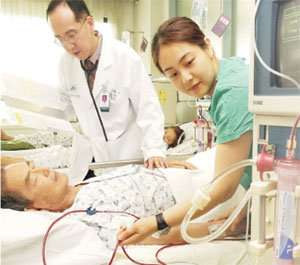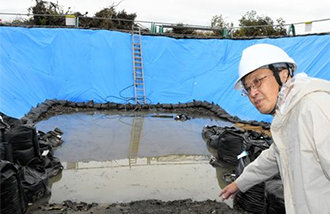Chronic Kidney Failure

The Korean Society of Nephrology (KSN) said that the number of patients who have chronic kidney function impairment is approximately 600,000. Due to the westernized dietary habits and the rising diabetes and high blood pressure, such patients are increasing 15-20% every year. Especially, terminal patients who need a kidney transplant or dialysis (a method of removing toxic substances from the blood when the kidneys are unable to do so) as their kidneys are destroyed 80-90%.
Although there is a wrong perception that kidney failure is common among old people, those in their 30`s and 40`s can have the disease. Prevention and early diagnosis are very important because the disease can destroy an individual and his/her family.
Kidney is known to be a filter of human body. This multifunctional system of human body not only removes toxic substances from the blood but also has various functions.
Kidney controls the blood pressure, water, electrolytes, and acidity. In addition, it activates vitamin D and produces hormones that play a pivotal role in making red blood cells.
There are acute and chronic kidney failures. The former is caused by drug abuse, bleeding, operations, and a certain disease while the latter develops gradually.
Acute kidney failure can be cured with injection of linger`s solution, dialysis, and medication.
The problem is chronic kidney failure. The most common type is kidney inflammation caused by diabetes, followed by mal-functioning glomerulus (One of the structures which comprise the nephron (functional unit) and filters wastes in the kidney), high blood pressure, and substance abuse.
When your mouth smells like urine and you often feel nauseated, you could end up with dialysis. When you start getting dialysis, however, it will become a life-long therapy. So many of patients are despaired at first, but the fact is that they can remain the quality of life at about 80% of normal people by going through the therapy right.
There are two kinds of dialysis. Blood dialysis takes out some of the patient`s blood to purify it and put it into the patient`s body again. For blood dialysis, you have to visit hospitals specializing in dialysis.
Doctors create a special blood vessel in the patient`s arm and start the therapy about two to four weeks later. Then the patient will have to go through four to five hour-long dialysis twice or three times a week. Some 20mL of blood will be taken out to be purified through a special device before being put into the patient`s body again.
Abdominal dialysis requires insertion of a tube into the abdominal cavity. With the tube, some 2L of dialysis fluid is put into the body for 15 minutes four times a day, and sent out six hours later. During the course, waste materials within blood are absorbed by the fluid and blood is purified.
For those working for companies during daytime, there is an ease-to-use automatic dialysis machine that works only at nighttime.
Yet, dialysis is not a permanent solution and many people are waiting for their turns to get a transplant. But those with hepatitis, heart diseases, strokes or are old will not be able to get a transplant surgery.
Diabetes and hypertension can be prevented by closely monitoring the level of blood sugar and tension. Patients, old people and people whose family member(s) have ever suffered from the diseases, need to take urine and blood tests every three or six months. If found at an initial period and treated well, the diseases will not develop into the stage requiring dialysis or transplant.
People need to be careful with what they eat. They must eat less spicy and less meat to avoid taking too much protein. They are required to eat meat, however, since meat is a source of amino acid. And also consult with your doctors to avoid medicines that can affect the kidney and take ones good for your kidney.
Health tips by Kim Soon-bae, professor of Ulsan Medical University and physician at Seoul Asan Hospital)
Seong-Ju Lee stein33@donga.com







